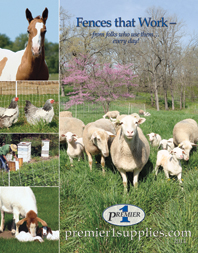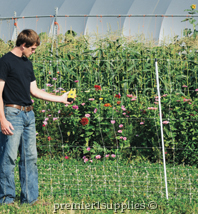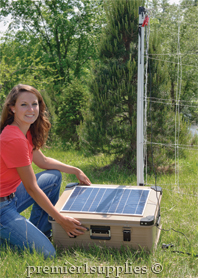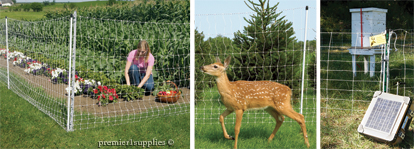NEW! FENCES THAT WORK BOOKLET
 New!
New!
2014 Fence Booklet
Look for it in your mailbox this week. It includes, along with our standard products, the following new items:
VersaNet® Plus 9/20/3
Less distance (6.8 ft) between line posts than VersaNet® 9/20/3 (11.5 ft). The extra posts reduce sagging between posts and enables the net to adapt to curves, hills and dips.
Folks who like fences to look neat and tidy almost always prefer our “Plus” nets whatever the height.
VersaNet® Plus 12/60/3
This is a “Stops Nearly Everything” net. 60" (5 ft) tall to stop large and agile animals like deer, elk, bears, dogs, coyotes and livestock.
Why use VersaNet® Plus 60 instead of PermaNet™, VersaNet® 30 or Deer QuikFence™?
HotShock® & IntelliShock® Energizers
(Expected mid-April 2014.)
Low cost, new design! 0.5, 1, 2 and 3 joule units that use either battery or plug-in power. IntelliShock DC units are variable draw—which means they use less energy when the fence is clean, thus increasing battery life and reducing cost.
Insulators
| • |
Corner Roller—Prevents conductor from slipping off. Smooth roller prevents wear on conductors. Safer—plastic pin breaks if a horse crashes into fence. |
| • |
Double Pigtail Offset—Holds conductors on opposite sides of wooden post. For use with rope and narrow tape. Tolerates moderate up/down strain. |
Stainless Steel Spring Gate
New stainless steel option. This gate is popular and effective. It fully retracts when expanded. Uncoiled spring measures 16 ft.
PREMIER NETTING

VersaNet® 60 deters deer from making a meal out of well-tended gardens. Using an EZ Digital Voltmeter to check fence voltage. Just touch the contact points to an electrified strand.
Premier is the source of 80% of the USA's electric netting. And we're the world leader for new netting designs and uses!
Why Premier “knows” netting…
| • |
We’ve used it for 44 years (since 1970)—longer than anyone in the US. |
| • |
It’s in use 24/7 at Premier to fence sheep, goats, poultry and dogs in—and to fence deer, coyotes, and stray dogs out. |
| • |
We talk daily to netting users nationwide—who let us know what they like and/or dislike; when it works and when and why it doesn’t. |
| • |
View our Netting Comparison Chart to compare all of our nets. |
We have 3 netting videos available:
ENERGIZERS

When using a PRS Solar Energizer during the summer months, face panels upward to take advantage of the direction of available sunlight.
|
PRS Solar Energizers
Which unit is right for you?
The size, in pulse energy output (range from .5 joule to 2 joules), depends almost entirely on the weed contact that will occur and the length of the fence.
Contact Premier or call 800-282-6631 to speak with one of our fence consultants to help you determine the best energizer for your needs. We have a unique 2-year rapid replacement warranty on all of our energizers.
You can also view our energizer comparison charts online or in Premier's fencing catalog to help in choosing an energizer.
|
 |
 |

Electric netting used for Garden/Wildlife (far left photo), Deer (middle photo) and Bees (far right photo)
Before you buy or build a fence
Q. What is the fence’s location? Is it flat? Or does it go over hills and ditches and around curves? Is it covered with brush, trees or open grass? Are the soils rocky, very soft, sandy or firm?
A.The optimum fence design often hinges on answers to these questions.
Q. Do the animals know the fence?
A. Local animals and wildlife get to “know” a fence by appearance, location and “pain memory.” If it’s a strong or painful fence they avoid it. On the other hand animals new to fences may challenge them. That’s why strong, tall and visible permanent fences are essential.
Q. What specific animals need to be fenced in or out?
A. Always design and build for the most difficult species. Rules of thumb:
| • |
Deer jump with ease. Fences need to be tall or 3-D. |
| • |
Smaller garden pests easily walk beneath deer fences, spacings need the bottoms of fences must be close together. |
Q. Should you energize the fence?
A. It pays to do this. Why?
| • |
A “hot” strand has a “zone of pain.” So fewer strands are needed if one is energized. Both the material and the labor to install is reduced. |
| • |
Energized fences last longer and require less maintenance—because animals do not crowd, rub or scratch on them. So the fence wires (including wires that are not energized) require less tension to do their job. And braces and corner posts will last longer. |
| • |
Animals are more surely contained or excluded during breeding and weaning. |
Q. How keen will animals be to breach the fence line?
A. Build for the worst-case situation (if you can afford to do so).
Some situations that require more secure fences:
| • |
Hunger. Starved animals will eventually challenge most fences. |
| • |
Weaning. Strong physical barriers are needed. |
| • |
Breeding. Libido induces all creatures to challenge rules and especially fences. |
| • |
Boredom. Animals in corrals, stalls and feedlots crave any “entertainment” or activity. |
| • |
Gateways and handling yards. Animals often push each other into fences when being moved. |
| • |
Fear and fright. Predators or loud noises can cause “prey” species (e.g. horses, goats, turkeys) to run in terror straight into, under, over or through any fence, no matter what fence design (netting, high-tensile or woven wire). |
FENCING BOUNTIFUL GARDENS
Garden/Wildlife Barriers
The 2 basic design choices…
1. Netting
| • |
More expensive per ft (60¢ to $2.76). |
| • |
Best solution to keep out small animals such as dogs, rabbits, woodchucks, raccoons, foxes—and most nonflying poultry. |
| • |
Fast and simple to install. For a typical fence line, 500 ft can be installed in less than an hour. |
| • |
Needs no tools, strength or skills. |
| • |
Prone to energy problems from growing vegetation if fence line is not mowed or sprayed as needed. |
(see photo at right) Installing VersaNet 9/20/3 to protect sweet corn from raccoons. However, it's always best to mow the grass/weeds in the fence line very short before installing the net, so it can remain in place without mowing for a longer time.
2. Multi-Strand
| • |
Much lower cost per ft (11¢ to 25¢), which makes it attractive for long fences. Cost varies according to number and type of strands, spacing and type of post, etc. |
| • |
Can be as effective to fence out certain species (e.g. raccoons). |
| • |
Less prone to problems with fast-growing weeds if fence is to be left in one place for weeks. |
| • |
More prone to installation errors. |
(see photo at right) A fence around a garden that uses IntelliTape (0.5" wide) at the top for maximum visibility. Bottom conductor is IntelliRope. Posts are Step-in PowerPosts. Bottom strand repels raccoons.
Anti-Deer Fences
Choices…
Why some work and some don't…
The only 100% deer barrier is an 8 ft tall woven wire fence or solid wall. But they are both expensive and very permanent. An alternative is electrified fences. They rely upon a painful shock to persuade deer to neither jump nor penetrate a fence. Because they aren’t physical barriers, electric deer fences rely upon key deer behavior aspects.
| 1. |
Deer, like us, are creatures of habit. Where they choose to feed, rub, walk and breed are habits learned over time—a habit reinforced every time they do it safely. Suddenly fencing a deer herd away from an area or trail forces the herd to break a habit pattern. That is why the first days of denial of use (by a fence) is critical if the fence is to succeed. Once a herd’s pattern is broken, the change in feeding/walking location is easier to maintain. |
| 2. |
Deer make “risk-benefit” decisions about feeding sites, trails and rubbing trees. Electric fences use pain to raise the “cost” (the degree of risk and effort to use an area) and persuade deer that it is safer and less frightening to feed, rub or trail elsewhere. When they are desperate they may risk the pain—which is why you can’t keep out starving deer with electric fencing if the site is their only food source.
|
Read More »
(see photo at right) The space (3 ft) between the 2 fences confuses deer that would otherwise jump over a single vertical fence. Also, scent caps entice deer to get up close and take a sniff. The deer receive a shock when they touch the fence with their noses, and they quickly learn to stay away from it in the future. Fence is protecting FireSide Winery's (Marengo, IA) vineyard.
Beehive Protection
Two net choices…
The fence is as visible to hogs at night as possible (contrasting black and white).
Because it’s so easy to use and adapts readily to most situations, netting has become the way to protect hives from bears, wildlife, livestock (cattle, sheep, goats, pigs) and feral hogs.
A word of advice: Fence is unable to contain bees. But it does keep the hive safe from 4-legged pests.
Durability
If used with care Premier’s nets will last up to 10 years. Don’t allow the grass around it to become overgrown—because folks tend to tear the net during removal.
(see photo at right) Using ElectroNet® 9/35/12 at Wehr Honey Farm, Keota, IA.
|
|